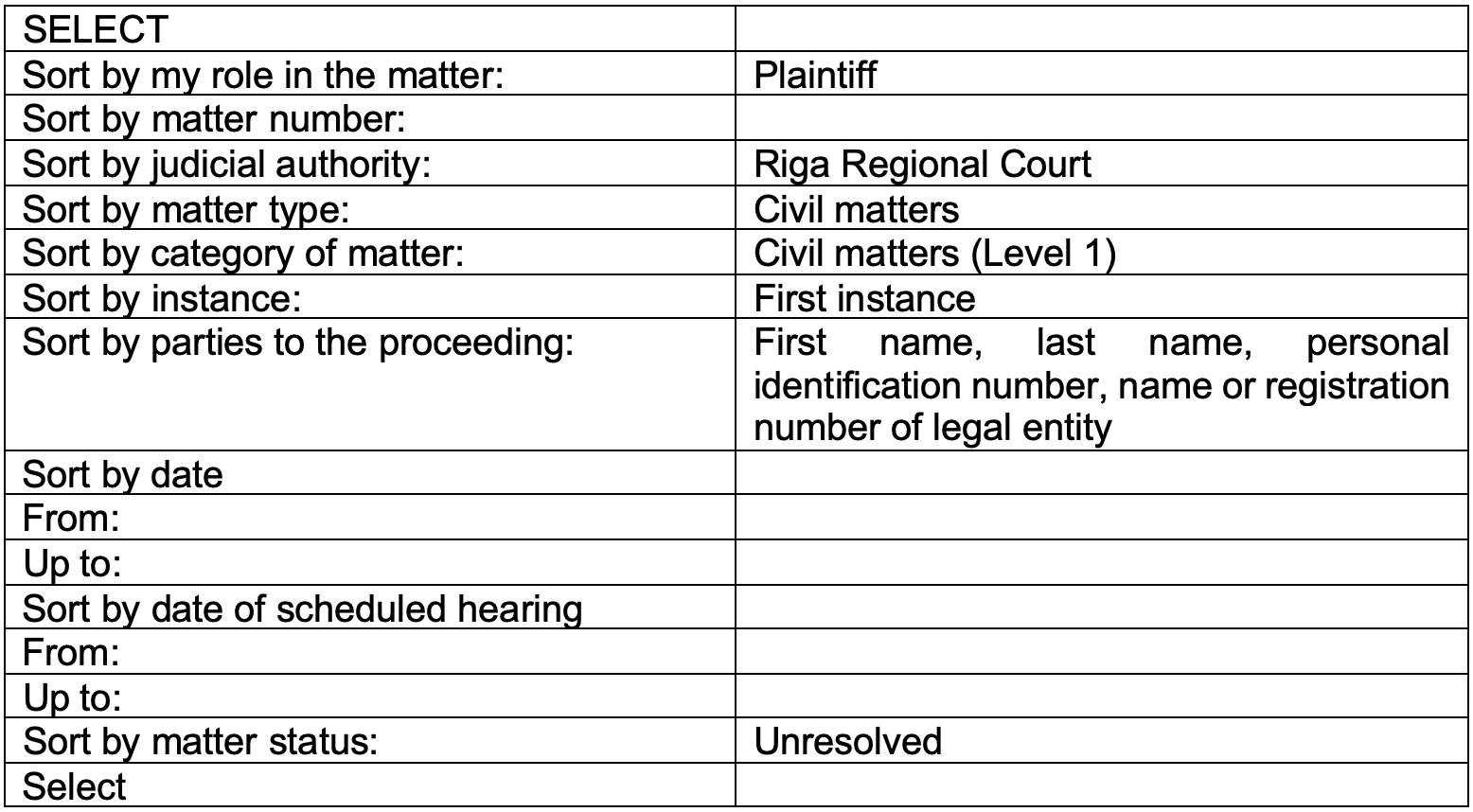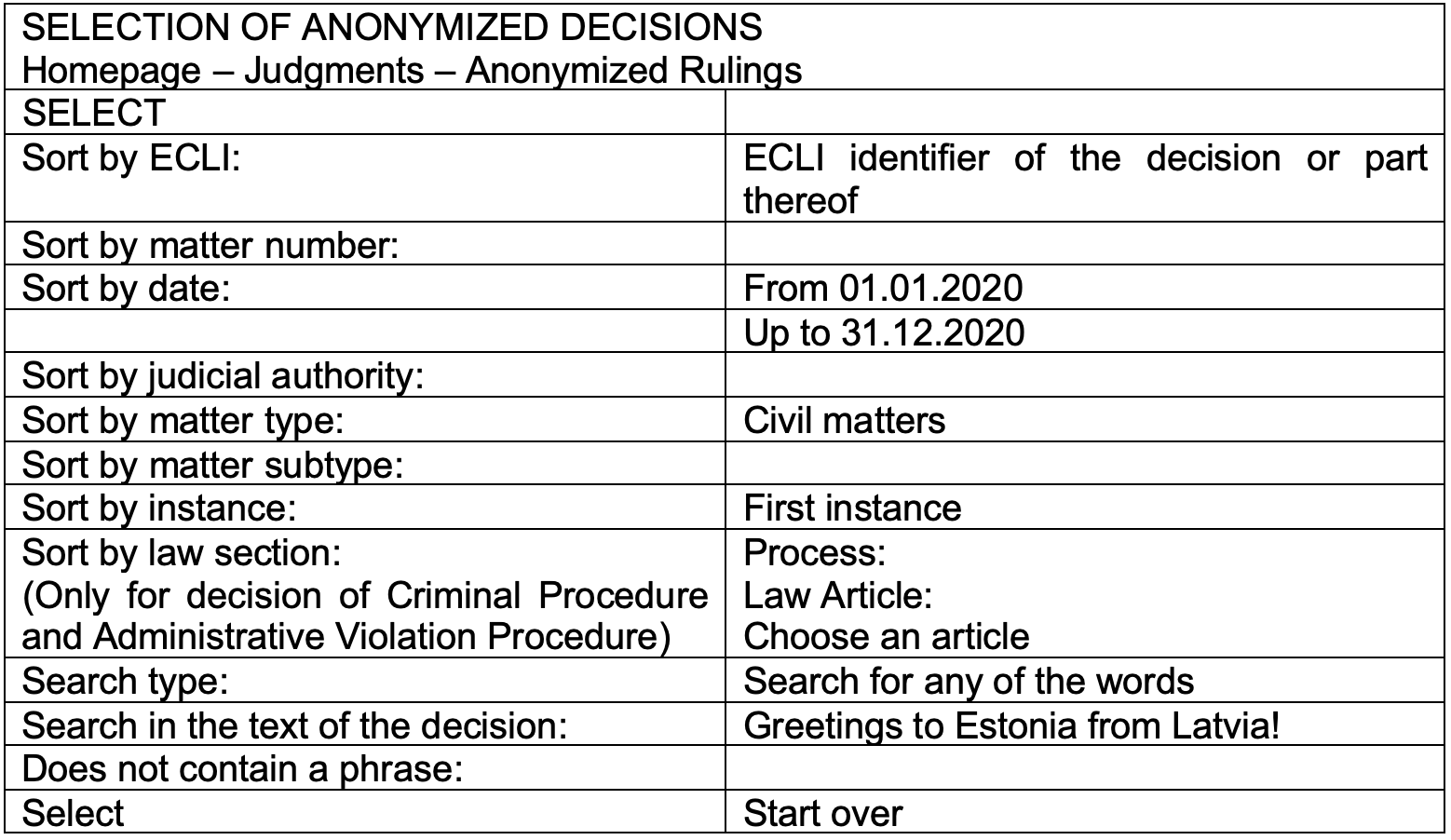Jānis Dreimanis
Deputy Head of Project Management and International Cooperation Section at the Court Administration
Introduction
Since the establishment of the Court Administration in 2004[1], the Latvian court system has received continual, professional support in various areas, from financial-technical security to centralized personnel management to financial accounting and all the way to implementing and providing support for the newest information technology.
In twenty years we have come a long way and, looking back, we can see that Latvian court budgets no longer include the purchase of typewriters, court clerks no longer deliver summonses on their way home from work and judges and court staff are no longer paid their salaries out of big, black bags at the beginning of each month.
On the contrary, the Latvian court system is now better secured for work than ever before, using world-renowned information and communication technologies that make the functioning of the judiciary significantly smoother and the resolution of matters very efficient and dynamic.
Thus, for example, matters involving the recovery of debts and claims for damages were resolved in an average of 12 months in 2010 but can already be solved in 6.8 months in 2019. And 65% of such matters were resolved within six months.
Court Technological Solutions and e-Services
Since 2012, when the Latvian-Swiss cooperation program individual project “Modernization of Courts in Latvia” was completed, Latvian courts have been outfitted with videoconferencing equipment. Every court room has sound recording equipment that, along with its innovative sound recording software, was nominated for the CEPEJ prestigious Crystal Scales of Justice Prize[2] in 2015.
The provision of videoconferencing equipment in courts and detention facilities has solved situations where the parties to a proceeding cannot appear in court because they are in a medical facility, under house arrest, in another city or even in another country. Thanks to this innovation, the number of requests for escorting detainees from detention centers to court made to the Latvian police has also decreased significantly. In 2019, videoconferencing was used 95,000 times for a total of nearly 11,000 hours.
The Latvian court e-service portal manas.tiesas.lv[3] was created and managed by the Court Administration and has been operating successfully for six years now. It accumulates different materials and the e-services of over ten courts together in one place.
Individuals can use the court portal to electronically sign and submit various applications and requests. There are electronic forms for different applications that are filled in with the aid of a wizard. This allows the person to prepare the application for a court step-by-step and without making mistakes.
The parties to a proceeding are able to subscribe for updates about their court matter and its process by e-mails. As part of the service, an automatic e-mail is sent to all parties of a proceeding when any new actions, decisions, status changes are made or decision files or digital protocols are added to their matter.
The court e-services portal can also provide information on the progress of a court proceeding: by entering a matter or subpoena number, you can get information about the progress of the matter, the next scheduled hearing and the courtroom where the hearing will take place.
The portal includes the important service “My Things”, which allows the parties to keep track of the matters they are involved in and gives them access to all relevant electronically attached documents, including court decisions and digital protocols.
Digital protocols are available as structured PDF files that include audio recordings. The file includes the court clerk’s notes which have links to the appropriate section in the recording.
Whereas in the past, it took seven days to submit and prepare notifications concerning a matter file (requests to the court, preparation of the material and the subsequent issuing of that material), then the e-service makes it possible to get these notifications from the manas.tiesas.lv portal in one minute.

The e-service portal also gives access to anonymized matter decisions, i.e. decisions that have entered into force but which have content that has been anonymized before being made public. Searches of such court decisions can be made using phrases, series of words or the court, instance or type of proceeding and they can be accessed as machine-readable PDF files.
At the end of 2019, 250,000 Latvian court decisions were available to the public after being anonymized using algorithms and selectively reviewed by the staff of the Court Administration.
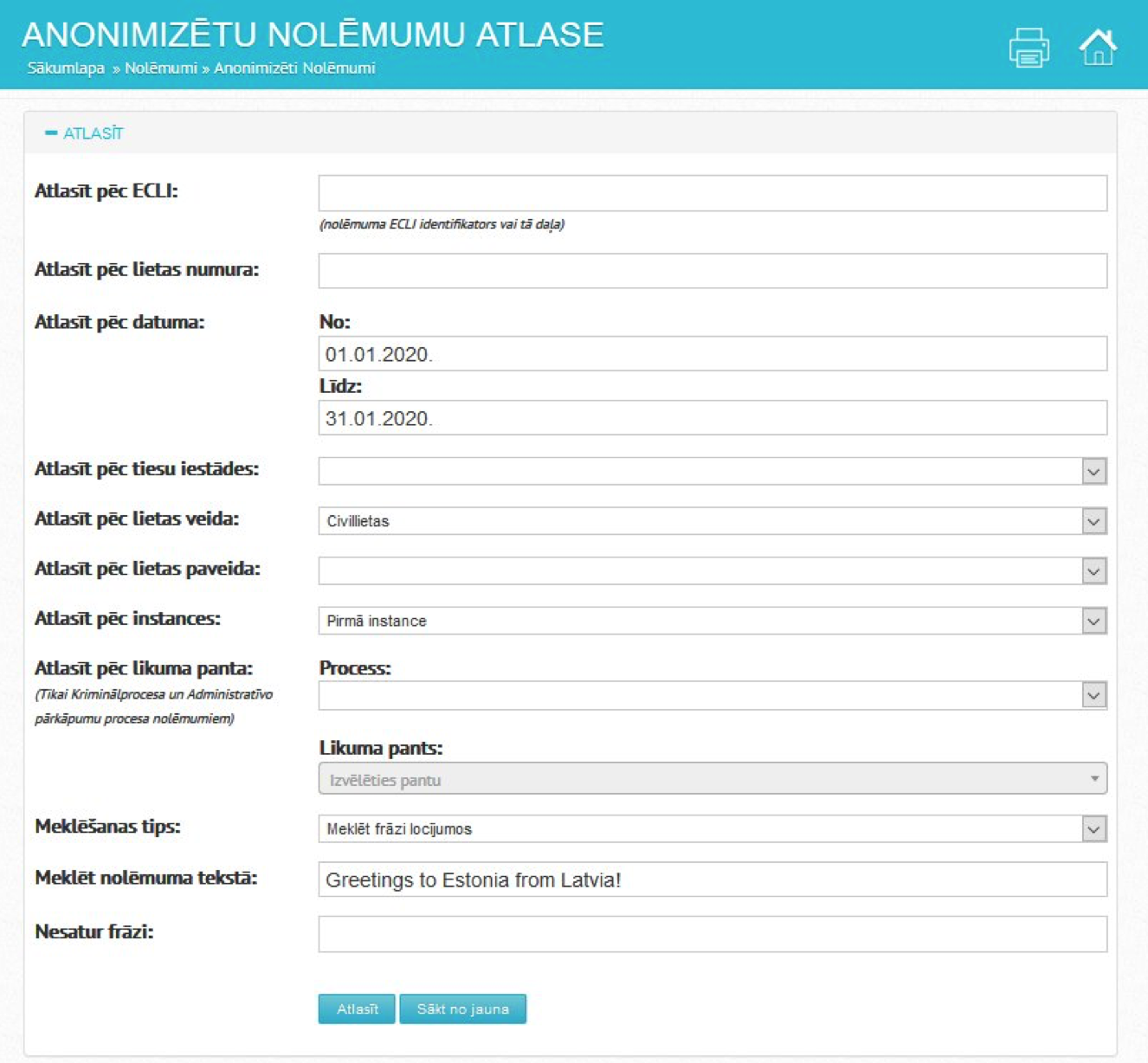
People also have access to court calendars, which provide information on scheduled hearings, matter numbers, parties to a proceeding (plaintiff, defendant, accused), the nature of the matter (sections of law on the accusation) and the judge hearing the matter.
In order to avoid postponement of hearings whenever possible and to discipline the parties to a proceeding, the Court Administration has created a calendar of lawyers and prosecutors. Courts can also access this to find out a lawyer’s workload early enough to use this information to decrease the number of postponed hearings. The calendar ensures that lawyers and prosecutors receive information from the court about the scheduled hearings that require their attendance and gives them the opportunity to enter information about their schedules in the calendar. The information that lawyers and prosecutors enter in the calendar reaches all the courts.
The court e-service portal is visited by about 1.5 million users yearly, including day-to-day practitioners, i.e. lawyers and legal practitioners, and first-time users, such a the plaintiffs and defendants involved in proceedings. Information on the 37,000 unresolved court matters registered in the court information system can be accessed by the parties 24 hours a day, seven days a week.

At the end of 2019, the Court Administration introduced a virtual assistant into the Land Register portal[4]. The assistant named Justs (from the word justīcija, ‘justice’) helps people find their way around the services offered by the Land Register and, in the future, it will give advice to visitors about all of the Court Administration’s websites and services offered.
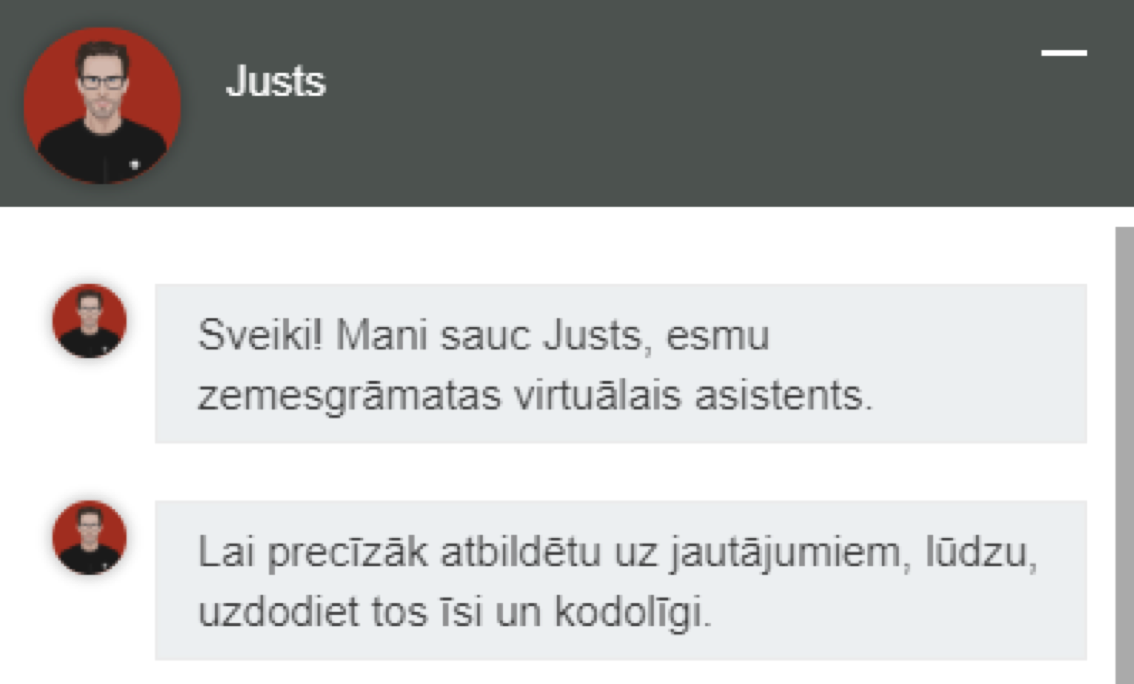
Screenshot translations:
The virtual assistant makes communication more accessible and friendly. People don’t have to go to court offices in person, which saves them time and money. And they don’t have to wait for an attendant because their questions are answered immediately.
In addition to answering people’s questions, Justs also reduces the workload of court staff, doing the technical, routine work for them and leaving them to do tasks with higher value-added. This also makes the agency more efficient.
Business Analysis
Since 2016, the Court Administration has consistently developed the capacity to process court-related data to make it easily accessible, always accurate, dynamic and easily processed.
In 2020, a wide range of data on the work of the courts will be available for use by judicial authorities (the Ministry of Justice, the Council for the Judiciary, the Presidents of the Courts) as well as lawyers, journalists and others.
Dozens of reports and visualizations on the work of the courts are available on the court public data portal[5].
Using the possibilities offered by the platform, the business analysis experts of the Court Administration compiled more than 900 different data reports in 2019, from relatively simple reports to the modeling of the workload of the economic court[6].
For day-to-day work, comprehensive data on the work of the courts and judges in different divisions is permanently available[7], and this includes graphical information about the number of matters received, resolved and pending by type and category of proceeding. Information is also available on the exact duration of proceedings, planned hearings, requests received in the course of a proceeding, and the rulings made and actions taken on matters.
Information on pending matters that took longer to resolve than the same type of matters did the year before is also available to the public. Anyone interested can look at these matters and see the duration of the settlement or lack thereof (with or without suspension of the proceeding) and the actions taken during the proceeding. This promotes the transparency of the legal system and trust in the judiciary per se.
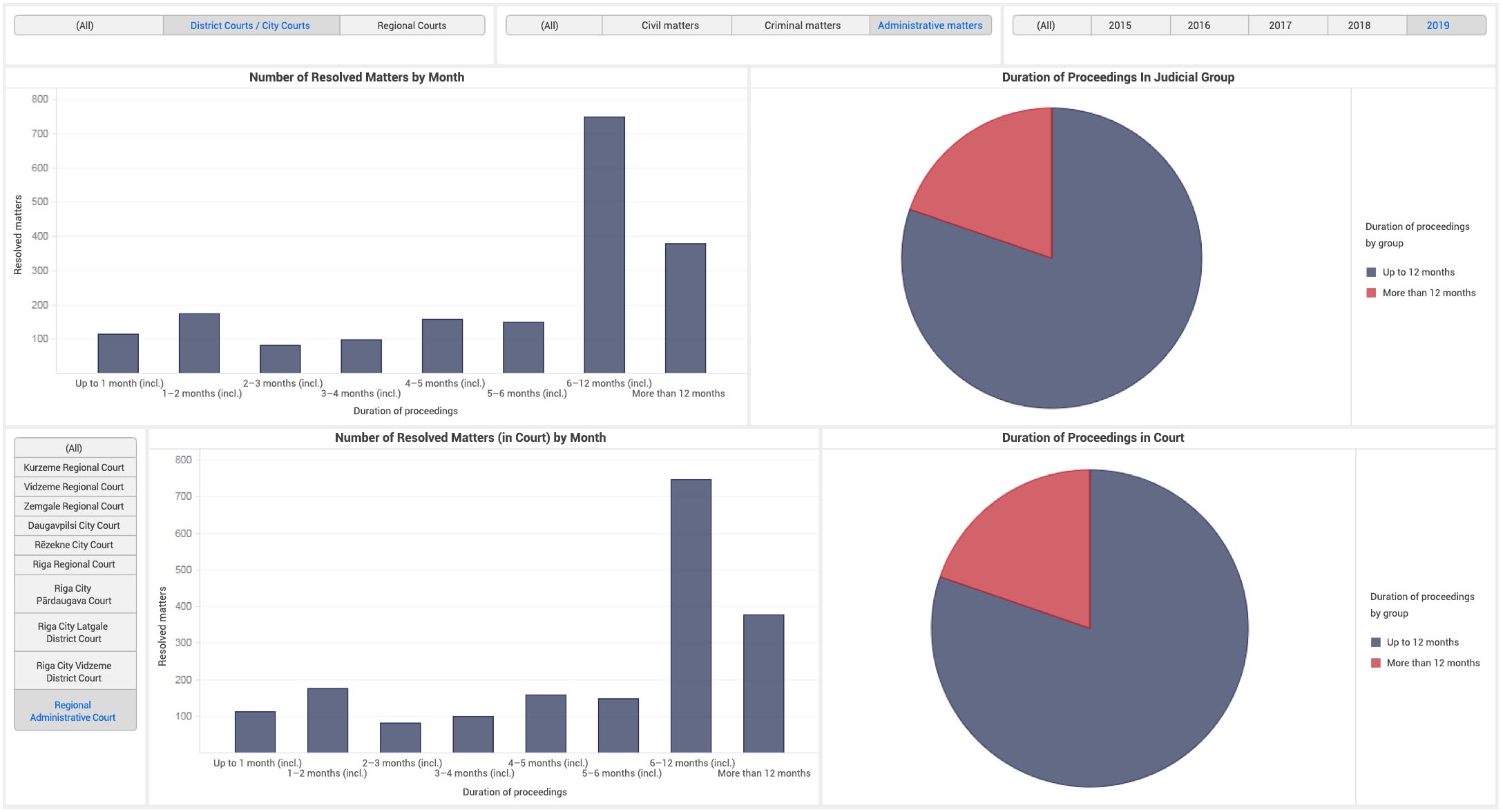
On the business analysis platform, the Court Administration processes data from several state information systems, including the court information system and the sate central computerized land register as well as the Court Administration internal information systems, i.e. their personnel management, financial accounting and administration systems.
Based on data processed through the business analysis platform, in 2019, the Court Administration created automated notices to evaluate the performance of judges and calculate the costs of court hearings and matters. Staff of the Court Administration and the Ministry of Justice are periodically sent prepared reports with up-to-date information on the work of the courts as well as information on the absences of staff or judges, on tasks being monitored, and notices of judges who are nearing the date of their routine evaluations.[8]
In 2020, the Court Administration plans to take advantage of the existing opportunities and transfer information in open data format to portals in Latvia and across the European Union[9], submitting notices of received and resolved matters and information about what materials are available on those matters in the courts information system.
Using the available data, at the end of 2019, the Court Administration created a prediction model for the duration of civil matters[10] that predicts how long it will take to resolve a certain matter. The prediction is based on a machine-learned model that includes information on previously resolved matters, judges, courts, types of matters, durations of previous matters, data on the parties to proceedings, etc. This tool will be used to create new e-services for courts and will also be added to the existing e-services, such as “My Things”.
Robotic Process Automation (RPA)
In order to improve and simplify work and reduce monotonous activities, the Court Administration started a pilot project in 2017 to introduce the processes of robotization into court institutions.[11]
Automation of jobs can free up people from doing monotonous work, allowing them to commit to more creative and important tasks and reducing the risk of human error, thus significantly increasing the quality of their work.
As a pioneer in the use of RPA in public administration, the Court Administration has been exploring and successfully implementing solutions for years[12], thereby reducing the amount of low value-added, manual, repetitive work that authorities have to do. As a result, the Court Administration successfully robotized two processes by the end of 2019 and plan to complete the robotization of a third process. At present, they are:
- processing the invoices for paid court services and adding them to the resource management system;
- processing the state fees for applications made to the enforcement proceeding register and linking them to the enforcement proceeding: the state fees tied to the application are recognized and linked to the resource management system;
- future calculation of recurring land register state fees in the resource management system: data is obtained from the state’s central computerized land register and the state property cadaster information system; plans are to robotize the processing of state and office fees for all approved applications that are presented to district (city) courts every year.
The implementation of RPA projects enables employees to focus on more meaningful and higher value-added work and prevents possible errors in data processing.
The Court Administration is also ready to continue reviewing processes taking place in institutions and courts to assess their suitability for robotization, such as the optimization of workflows in the personnel management field or robotic processing of incoming and outgoing correspondence, leaving the classification of documents according to nomenclature to the employee. They are also considering using RPA to robotically process uniform information on land register applications, thus freeing assistant judges of monotonous and repetitive work.
In recent years, RPA has become increasingly popular and enticing all over the world but you need experience and knowledge to take advantage of the technology afforded by the Fourth Industrial Revolution. By acquiring such experience and knowledge, the Court Administration can use the considerable advantages of RPA as it continues to develop the field of court procedure, which is one of the most progressive in Latvia.
E-File
One of the biggest challenges for the Court Administration[13] is the creation of one shared digital platform that would ensure efficient and electronic proceedings.
The purpose of the e-file program is to create a complete, electronic process that incorporates all stages, from the beginning of a matter, through its processing and all the way to its completion. Initially, four law enforcement institutions will join the shared digital platform but there are plans to increase the number of participants in the future.
The first stage of the e-file program will be implemented across three years and the project is scheduled to be completed in the first quarter of 2021.
The need for a common, shared information platform for national and judicial institutions has been discussed for some time.[14]
The government has declared[15]: „Despite today’s technological possibilities, criminal proceedings, administrative offense proceedings, administrative court proceedings and civil court proceedings are largely tied to the exchange of paper documents, including among the institutions involved in the proceedings.”
The document also emphasizes the need to promote the digitization of these processes at all stages and to establish cooperation between institutions and bodies involved in the process. To achieve these goals, an e-file program has been developed, which includes the development of several different information systems and cooperation in order to achieve:
- the digitization of materials in criminal proceedings, administrative court proceedings, civil court proceedings and administrative offense proceedings to increase access;
- making materials available electronically to the authorities and individuals involved in proceedings in the form of e-services, which increaes inter-institutional cooperation and reduces the bureaucratic burden on public authorities and individuals;
- improving data storage and exchange solutions to make information systems more functional and the work of institutions more efficient.
While the shared e-file system is created, the court system is also being modernized in other areas, such as the development of innovative tools that incorporate elements of artificial intelligence. For example, if the system is able to analyze existing information, compare it to behavioral models from similar situations and then make suggestions about possible courses of action, it would make analyzing a specific question much easier for specialists.
Conclusion
The aim of the Court Administration is to provide administrative support to courts and land registers. As a modern and development-oriented public authority, the Court Administration uses all the resources at its disposal to provide the judiciary with the best technological solutions to simplify their day-to-day work. The Court Administration is constantly exploring and searching for new ways to implement innovative solutions to keep the judiciary a step ahead of others.
The Court Administration appreciates the opportunity to contribute to the Yearbook of Estonian Courts and hopes that the successful cooperation between the Estonian and Latvian legal systems will continue in the future.
____________________________
[1] Government Regulation No. 589 of September 30, 2014 “Regulation on the Court Administration”. Available online: https://likumi.lv/ta/id/269261.
[2] Available online: https://www.coe.int/en/web/human-rights-rule-of-law/crystal-scales-of-justice.
[3] Available online: https://manas.tiesas.lv/eTiesas/.
[4] Available online: https://www.zemesgramata.lv/.
[5] Available online: https://dati.ta.gov.lv/.
[6] Government Regulation No. 407 of August 22, 2019 „Conceptual Report ‘On the Establishment of the Economic Court’”. Available online: https://likumi.lv/ta/id/308908.
[7] Available online: https://youtu.be/0hd8o5ilXyY.
[8] Routine evaluations of judges are part of a regular procedure prescribed by law. (editor’s comment)
[9] Local portal: https://data.gov.lv/lv, European Union portal: https://data.europa.eu/.
[10] Available online: https://tiesas.lv/aktualitates/tiesu-administracija-strada-pie-projekta-kas-prognozes-lietu-izskatisanas-ilgumu-9166.
[11] Tiesu administrācija sāk ieviest robotizāciju. Jurista Vārds, 29.08.2017., No. 36 (990), 5.lpp.
[12] Dreimanis J. Automatizēto procesu robotizācija un datu pieejamība. Jurista Vārds, 07.01.2020., No. 01 (1111), 44.–48.lpp.
[13] Available online: http://at.gov.lv/lv/jaunumi/par-tieslietu-padomi/tiesu-administracijas-lielakais-izaicinajums-e-lietas-projekts-9620?
[14] Available online: https://lvportals.lv/tiesas/294297-vienotu-e-lietu-ieviesis-tris-gadu-laika-2018.
[15] Available online: http://tap.mk.gov.lv/mk/tap/?pid=40331567.




